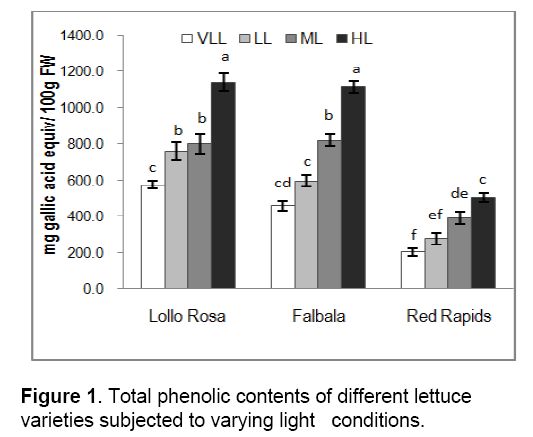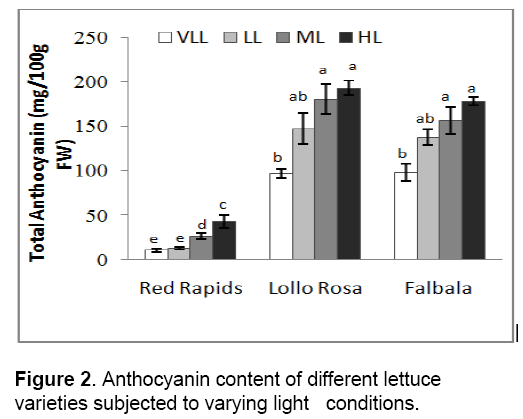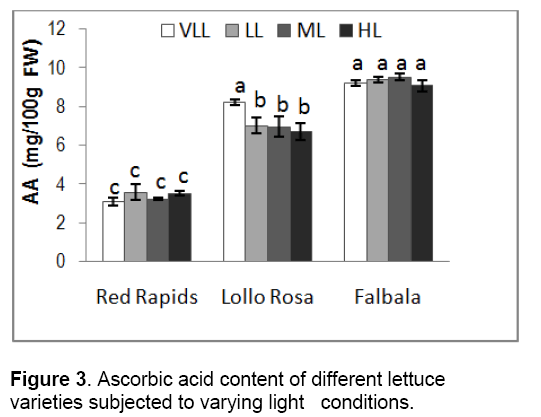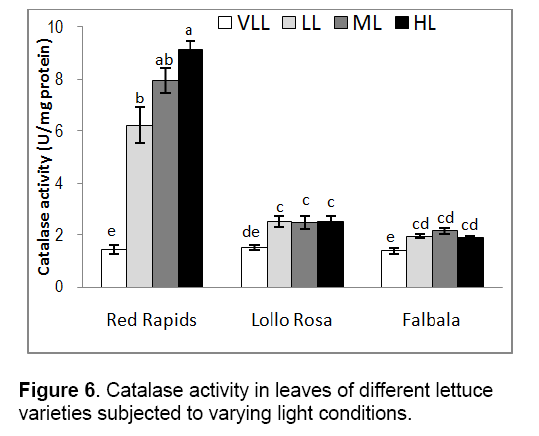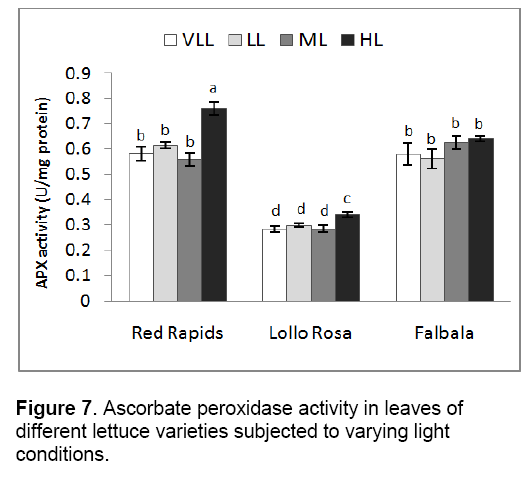Impact of Light Variation on the Antioxidant Properties of Red Lettuce
Regina Lourdes B. Hipol, Maribel L. Dionisio-Sese
1School of Natural Sciences,Saint Louis University,Baguio City 2600,Philippines
2Institute of Biological Sciences,College of Arts and Sciences,University of the Philippines Los Baños,Laguna 4031,Philippines
- Corresponding Author:
- Regina Lourdes B. Hipol
School of Natural Sciences
Saint Louis University,Baguio City 2600,Philippines
E-mail: rlbhipol@gmail.com
Abstract
Three red lettuce (Lactuca sativa L.) varieties, Red Rapids, Lollo Rosa and Falbala, were grown in greenhouse and subjected to varying levels of light using shade nets two weeks before harvest to determine the effect of these conditions on the antioxidant profile of the plants. When lettuce was exposed to increasing light intensities, i.e. very low light (VLL), low light (LL), medium light (ML) and high light (HL) conditions, leaf growth was enhanced specifically in Red Rapids and an increasing trend in total phenols (TP) and total anthocyanins (TA) was observed. These findings were associated with the enhanced radical scavenging activity in these varieties. The activities of the enzymatic antioxidants superoxide dismutase (SOD) and catalase (CAT) were also increased at ML and HL as compared to plants under VLL and LL. Ascorbate peroxidase (APX) activity, on the other hand, only increased at HL in Red Rapids and Lollo Rosa. Varietal differences were observed with the non-enzymatic antioxidants evidently higher in the deep red varieties while the antioxidant enzymes were higher in Red Rapids at higher light conditions. This research demonstrated that growing red lettuce at ML and HL two weeks prior to harvest increases the synthesis of health-promoting antioxidants in the fresh produce. This method offers a feasible strategy to increase the market value of the crop.
Keywords
Lactuca sativa,high light stress,antioxidant activity,phenolics,antioxidant enzymes
1. Introduction
Plant phenotype,including the biosynthesis of phytochemicals,has always been said to be the product of the interaction of the genotype and the growing conditions within which the plant is situated [1,2]. One of the abiotic factors that is established to influence the production of phytochemicals is light [3,4]. In the study of Merzlyak and Chivkunova [5],they have found that the synthesis of the antioxidant compound anthocyanin is strongly dependent on light intensity. Moreover,another study pointed out that plants exposed to high light are observed to have a rapid induction of cytosolic ascorbate peroxidase genes resulting to the production of this potent antioxidant enzyme [6]. These findings may therefore be used to conclude that plants under light stress do undergo a number of changes in their metabolism and pigment composition in order to cope with and survive in these new environments [5]. There is currently an increasing interest by consumers to the health and nutritional aspects of the different products that they consume.This had led to interest in research not only in the evaluation of fruit and vegetable antioxidants but also on their improvement through crop breeding,cultural practices,and postharvest handling and processing [1,7]. One of the more important Cordillera-grown upland vegetable having this healthy food tag is lettuce (Lactuca sativa L.). In the study of Li and Kubota [3],they investigated the effects of supplemental light on the phytochemicals of baby leaf lettuce. They found that phenolic concentration increased by 6% with supplemental red light in comparison to the white light control while supplemental far red light decreased anthocyanins,carotenoids and chlorophyll concentration by 40%,11% and 14%,respectively. In another study by Zhou et al.[8],normal daylight plus artificial light was used to enhance phytochemicals in green lettuce,which may not be practical for some local farmers.
Information on crop quality in relation to health-promoting phytochemicals and antioxidants in lettuce grown in varying levels of light is limited. This is the gap that this research intends to tackle. Antioxidant content is becoming a progressively more important parameter with respect to fruit and vegetable quality such that researches on its induction are significant undertakings. In this experiment,different light conditions generated by using shade nets was used to determine the relationship of ambient light levels with enzymatic and non-enzymatic antioxidant levels. To our knowledge there is no literature investigating the effects of light stress on the levels of phenolic,anthocyanic and antioxidant enzymes in locally available red varieties of lettuce (Red Rapids,Lollo Rosa and Falbala). This study thus aims to investigate the impact of light variation on the antioxidant profile of these crops.
2. Materials and Methods
2.1 Plant Material and Growth conditions
Three red lettuce varieties were used; Lollo Rosa and Falbala are the deep-red varieties while Red Rapids represents the light-red variety. The seeds of these varieties were grown in seed beds and maintained in greenhouse located at Lamut,La Trinidad Benguet. Seedlings grown in each seed bed (fifty holes) were thinned to two when they have developed two true (expanded) leaves. At 21 days after sowing,seedlings of equal heights were transplanted into plastic pots (20cm diameter and 25cm height) and were maintained in the greenhouse with installed shade nets [80% shade with mean photosynthetic photon flux density (PPFD) of 260 μmol m-2 sec-1]. One week after transplanting,the seedlings were thinned to one per pot and were allowed to grow for another 14 days prior to assignment of treatments.
At six weeks after sowing,the plants were grown under four conditions of greenhouse shade (3,2,1 and 0 shade net,respectively) with the following percentage shade and mean PPFD at midday: Very low light (VLL): 80% shade (mean PPFD of 260 μmol m-2 sec-1); Low light (LL): 56% shade (mean PPFD of 600 μmol m-2 sec-1); Medium Light (ML): 35% shade (mean PPFD of 890 μmolm-2 sec-1); High light (HL): 0% shade (mean PPFD of 1,400 μmol m-2 sec-1).Light was measured with a light meter (LICOR,model LI-250,USA). All pots were maintained for another 14 days. The light levels were measured at midday and the mean computed. Plant growth and antioxidant components were measured after the treatments. Plant growth was determined by measuring leaf area,leaf length and leaf width.
2.2 Assays for the Non-enzymatic Antioxidants
For the analysis of total phenolics (TP),extraction and assay procedure followed the method employed by Volden et al. [9]. TP content was expressed as mg gallic acid equivalents (GAE)/100g fresh weight. Total anthocyanin (TA) content of lettuce was measured using the pH differential method of Sun et al. [10] and ascorbic acid was determined following the method described by Barros et al. [11].
Antioxidant activity was determined through radical scavenging activity which was assayed according to Duan et al.[12]. The inhibition of DPPH radicals by the samples was calculated according to the following equation:

where As = absorbance of the sample; Ab = absorbance of the blank and Ac is the absorbance of the control.
2.3 Assays for Enzymatic Antioxidants
Each 0.5g leaf sample was homogenized and proteins extracted according to Posmyk et al. [13]. All operations were carried out at 1-4˚C. The activities of superoxide dismutase (SOD),catalase (CAT),ascorbate peroxidase (APX) and the tissue protein content were assayed as previously described [13,14].
2.4 Statistical analysis
Data obtained from the physiological parameters were subjected to analysis of variance using the Statistical Package for the Social Sciences (SPSS) version 17.0. Means were compared using Student Neumann-Keuls at 5% level of significance. The study was conducted using a Completely Randomized Block Design. In all the assays,there were three replications and one replicate consisted of five plants.
3. Results
3.1 Effect of Light Variation on Leaf Growth of Lettuce
The varying light treatments significantly affected leaf area of the lettuce varieties (Table 1). Red Rapids exhibited the highest leaf area as compared to the other varieties under ML and HL conditions while VLL condition generally caused the lowest growth in terms of leaf area except in Falbala. The same trend can also be observed in all the lettuce varieties with regards to leaf length. Leaf width,on the other hand,was generally similar under LL and increased under ML and HL relative to VLL condition.
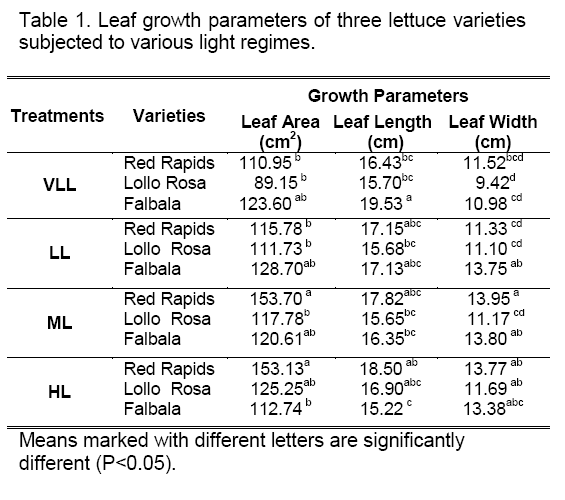
3.2 Effect of Light Variation on the Non- Enzymatic Antioxidants of Lettuce
An increasing trend in TP was observed with increasing light intensity across the three varieties (Figure 1). The highest increase in TP was recorded under HL. In all the light conditions,Red Rapids consistently had the lowest measured TP as compared to the other two varieties.
TA content followed a similar increasing pattern as that of TP across the different light treatments (Figure 2 ). Highest TA content was found in Lollo Rosa while a 59% and 82% increase was observed in Falbala at ML and HL. Similar with TP,the TA measured in Red Rapids at all the light conditions were consistently the lowest of the three varieties.
AA content was less modified by light variation in lettuce leaves as compared to TP and TA contents specifically in Red Rapids and Falbala (Figure 3 ). A decline in ascorbic acid content,however,was recorded in Lollo Rosa as compared to those grown under VLL.
3.3 Effect of Light Variation on Antioxidant Enzymes
In Red Rapids,SOD activity rose by an average of 30% at LL and ML as compared to VLL and showed its highest increase at HL (44%) (Figure 5 ).On the other hand,the SOD activity increased by 2.3 fold at ML and HL in Lollo Rosa,showing the highest increase among the varieties. As to CAT activity,the less red variety,Red Rapids,remarkably increased by four-fold at LL,5.5-fold at ML and 6.3-fold at HL (Figure 6 ). On the other hand,in Lollo Rosa and Falbala,CAT activity increased at LL and were maintained at these levels in ML and HL conditions.
4. Discussion
A number of factors including growing condition and genotype can have a large impact on the quality of vegetable crops,especially in relation to their health-promoting phytochemicals. Light influences biomass accumulation and the synthesis of such metabolites [3]. In this study,most of the antioxidants were generally enhanced with increasing light. HL-treated plants exhibited the highest leaf growth (Table 1) and antioxidant activities (Figure 4 ). Although high light intensities may lead to oxidative damage [15],these results generally suggest that the antioxidant system promoted better health and growth of the plants. This may reflect that whatever oxidative damage the plants experienced,it was masked by the increase in primary productivity resulting to increase in biomass.
Exposure to higher light condition at ML and HL led to a general increase in TP (Figure 1) and TA (Figure 2 ). These results suggest that increasing light may have led to the synthesis of these secondary metabolites,to counteract the increase in reactive oxygen species (ROS) induced at these high light conditions in the photosynthetic apparatus. The generated ROS may have activated the phenylpropanoid pathway in the leaves [5,16] resulting to the spike in measured TA and TP. This observation agrees with the study of Oh et al.[2] wherein they observed that lettuce grown in open field with higher solar radiation and possibly higher UV radiation had higher transcript levels for phenylalanine ammonia-lyase and α-tocopherol methyl transferase,which are involved in the biosynthesis of phenolic compounds and α- tocopherol. However,the research by Becker et al.[17] reported that growth of red lettuce in high light condition increases only flavonoid glycosides and not anthocyanins. Apparently,their conclusion was linked to possible non-stressful light exposure of 400 μmol m-2 s-1 which according to the authors may not be high enough to induce anthocyanin synthesis. Zhou et al.[8] reported that the light saturation point of loose leaf lettuce cv. Italian Champion was at 900 μmol m-2 s-1. HL treatments in the present study were above this,i.e. 1,400 μmol m-2 s-1. It could be inferred therefore that the saturation points for all the treatment varieties in the study was much higher. This is supported by the study of Bulthuis [18] which concluded that saturation could depend upon various factors including the genotype.
The differential capacity of the genotypes to synthesize phenolic compounds and anthocyanins was paralleled by their differences in the growth characteristics. Red Rapids exhibited the highest growth in terms of leaf area as compared to the other varieties especially under HL condition (Table 1). This may be attributed to the genotypic character of Red Rapids,a less-red variety which might have greater chlorophyll for light absorption. It has been shown that plants tend to accumulate high levels of carbohydrates under high light intensity [8] and more chlorophyllous genotypes have faster growth rate [19]. In addition,increasing light did not cause significant growth in Lollo Rosa and in Falbala,as it caused a slight decrease in leaf area as well as leaf length (Table 1). The increase in anthocyanin production in these varieties at ML and HL might have caused “shading” effect in the photosynthetic apparatus reducing light available to chlorophyll [20] and hence could have led to lower photosynthetic efficiency as compared to Red Rapids. This shading effect may have reduced the rate of biomass increase but it may have also further protected the plants from further oxidative stress.
Contrary to TP and TA,AA production was not enhanced by light in all the varieties (Figure 3 ). The results are in agreement with Li and Kubota [3] where supplemental light treatments (red,blue,green and UV light) did not induce ascorbic acid production in lettuce grown in growth chambers. Although it did not increase significantly with increasing light intensity,ascorbic acid could nonetheless compensate for ROS detoxification during light stress.
Increase in light promoted high DPPH scavenging capacity (Figure 4 ). This may be attributed mainly to increase in TP and TA as well as the maintained levels of ascorbic acid (apart from Lollo Rosa).These results are in agreement with a previous study that underscored the high antioxidant capacity of phenolic compounds and anthocyanins in red lettuce [21].Phenolics have notable antioxidant potentials that result to the observation of its several health promoting functions. Specifically,anthocyanins have been found to exhibit roughly four times greater antioxidant capacity than ascorbic acid [22].
Little work has been done on the effects of variations in light intensity on the biochemical components of lettuce,especially on the antioxidant enzymes. In this study,antioxidant enzyme activity was found to be dependent on light intensity. At LL and ML conditions,it was mainly CAT that showed enhanced enzyme activity (Figure 6 ). Under HL,all enzymes were found to have increased activities,generally suggesting that HL required higher protection against possible ROS production induced at higher light intensity. This compares well with other studies that demonstrated the enzymes’ vital role in scavenging radicals during high light stress [4].
SOD activity showed an increasing trend with increasing light levels (Figure 5 ). Previous studies have shown that SOD is induced by UV light and blue light[23],and interestingly was found to follow a diurnal rhythm implicating light regulation in its expression [24]. Moreover,the increase in the activity of SOD under high light treatment has been suggested to involve de novo protein synthesis [15].
CAT and APX activities were also enhanced at varying light intensities (Figures 6 and 7). CAT and APX are both important for the protection against lipid peroxidation through the removal of H2O2 and other hydroperoxides [6,25]. CAT activity was enhanced by increasing light intensity with Red Rapids exhibiting increase in CAT activity of up to six fold. CAT is present in peroxisomes,and is indispensable for ROS detoxification during stress conditions,when high levels of ROS are produced [26,27]. Thus,the strikingly high increases in enzyme activity in Red Rapids may indicate that this variety experienced high photo-oxidative stress and required high antioxidant protection through CAT synthesis. APX activity,however,was less enhanced by increasing light intensity as compared to CAT. This enzyme was enhanced only at HL condition while CAT activity was enhanced starting at LL up to HL in the three lettuce varieties. APX is localized at the chloroplast where possibly there is high requirement for ROS removal due to high light intensities [28]. At HL,the photosynthetic apparatus can be highly activated and hence,may generate more ROS,requiring higher demand for APX and other detoxifying enzymes. It is most likely therefore that both APX and CAT played a dominant role in H2O2 detoxification at HL while CAT was primarily involved for protection at LL and ML conditions. Since the biological function of these antioxidants is for the removal of hydroperoxides,higher activities would be beneficial for protection against lipid and DNA peroxidation [26].
CAT and APX are not completely redundant because they have different sites of localization [29] and they also do not compensate for the lack of each other [26]. Recently,a more critical effect of this detoxification has been suggested by Murata et al. [30]. They showed that the scavenging action of CAT and peroxidases are critical in accelerating the repair of photosystem II (PSII) by enhancing the de novo synthesis of the D1 protein,a key protein in the reaction center of PSII resulting to the enhanced protection of PSII against photoinhibition.
Also,it was Red Rapids that showed the highest increase in the three antioxidant enzymes’ activities under HL condition. This low-anthocyanin variety,therefore,may have activated more of its enzyme systems in order to protect its photosynthetic apparatus against high light than the deeper red varieties without a reduction in productivity as gleaned from leaf area (Table 1). Moreover,previous researches affirm that greener varieties are more prone to photo-oxidation than the more anthocyanic genotypes [22,31],thus needing a better complement of enzyme antioxidants to counter these situations. Nevertheless,Lollo Rosa and Falbala still had increases in enzyme activity however smaller in magnitude. Thus,the results of this study suggest that enzymatic content in lettuce can be enhanced by light,but the extent of the effect is dependent on the genotype.
Taken together,this study showed that red lettuce varieties exposed to higher light intensity had higher antioxidant capacity and enzyme activities. Improved DPPH radical scavenging capacity can be associated with anthocyanin and phenolic acids content,implying that these are the active contributors to the antioxidant pool in red lettuce. In addition,antioxidant response in relation to light was found to be mainly dependent on the genetic potential of the varieties. Maintaining a high level of antioxidative enzyme activities,especially in Red Rapids,may have contributed to better protection mechanisms,and to better growth. These results therefore suggest that subjecting lettuce to high light environments,two weeks prior to harvest,could be a feasible approach to increasing the health-promoting antioxidants in this fresh produce. This method can have an overall positive outcome,increasing the nutritional value of lettuce,particularly the phenolic and enzymatic content without a trade off in yield or appearance. This is the first report on the characterization of enzymatic and non-enzymatic antioxidants in the three red lettuce varieties.
Acknowledgements
This work was part of the doctoral dissertation of the corresponding author at the University of the Philippines Los Baños. It was supported by the Department of Science and Technology- Philippine Council for Health Research and Development.
References
- Boo,H.,Heo,B.-G.,Gorinstein,S.,Chon,S.-U.,(2011). Positive effects of temperature and growth conditions on enzymatic and antioxidant status in lettuce plants. Plant Sci. 181: 479–484.
- Oh,M.,Carey,E. E.,Rajashekar,C. B.,(2011). Antioxidant Phytochemicals in Lettuce Grown in High Tunnels and Open Field. Hort. Environ. Biotechnol. 52: 133–139.
- Li,Q.,Kubota,C.,(2009). Effects of supplemental light quality on growth and phytochemicals of baby leaf lettuce. Environ. Exp. Bot. 67: 59–64.
- Cakmak,I.,Marschner,H.,(1992). Magnesium deficiency and high light intensity enhance activities of superoxide dismutase,ascorbate peroxidase,and glutathione reductase in bean leaves. Plant Physiol. 98: 1222–1227.
- Merzlyak,M. N.,Chivkunova,O. B.,(2000). Light-stress-induced pigment changes and evidence for anthocyanin photoprotection in apples. J. Photochem. Photobiol. 55: 155–163.
- Morimura,Y. et al.,(1999). Light-enhanced induction of ascorbate peroxidase in Japanese radish roots during postgerminative growth. Plant Sci. 142: 123–132.
- Erkan,M.,Wang,S. Y.,Wang,C. Y.,(2008). Effect of UV treatment on antioxidant capacity ,antioxidant enzyme activity and decay in strawberry fruit. Postharvest Biol. Technol. 48: 163–171.
- Zhou,Y. et al.,(2009). Impact of Light Variation on Development of Photoprotection ,Antioxidants ,and Nutritional Value in Lactuca sativa L. J. Agric. Food Chem. 57: 5494–5500.
- Volden,J.,Bengtsson,G. B.,Wicklund,T.,(2009).Glucosinolates ,L -ascorbic acid ,total phenols ,anthocyanins ,antioxidant capacities and colour in cauliflower ( Brassica oleracea L . ssp . botrytis); effects of long-term freezer storage. Food Chem. 112: 967–976.
- Sun,J. et al.,(2009). Antioxidant activity of polyphenol and anthocyanin extracts from fruits of Kadsura coccinea (Lem.) A.C. Smith. Food Chem. 117: 276–281.
- Barros,L.,Ferreira,M.,Queiros,B.,Ferreira,I.,Baptista,P.,(2007). Total phenols ,ascorbic acid ,B-carotene and lycopene in Portuguese wild edible mushrooms and their antioxidant activities. Food Chem. 103: 413–419.
- Duan,X.,Jiang,Y.,Su,X.,Zhang,Z.,Shi,J.,(2007). Antioxidant properties of anthocyanins extracted from litchi ( Litchi chinenesis Sonn .) fruit pericarp tissues in relation to their role in the pericarp browning. Food Chem. 101: 1365–1371.
- Posmyk,M. M.,Kontek,R.,Janas,K. M.,(2009). Antioxidant enzymes activity and phenolic compounds content in red cabbage seedlings exposed to copper stress. Ecotoxicol. Environ. Saf. 72: 596–602.
- Jovanovic,Z.,Rakic,T.,Stevanovic,B.,Radovic,S.,(2011). Characterization of oxidative and antioxidative events during dehydration and rehydration of resurrection plant Ramonda nathaliae. Plant Growth Regul. 64,231–240.
- Chen,X.,et al.,(2011). The xanthophyll cycle and antioxidative defense system are enhanced in the wheat hybrid subjected to high light stress. J. Plant Physiol. 168: 1828–1836.
- Kreslavski,V. D.,et al.,(2013). Preillumination of lettuce seedlings with red light enhances the resistance of photosynthetic apparatus to UV-A. J. Photochem. Photobiol. B Biol. 122: 1–6.
- Becker,C.,Kläring,H.,Kroh,L. W. Krumbein,A.,(2013). Temporary reduction of radiation does not permanently reduce flavonoid glycosides and phenolic acids in red lettuce. Plant Physiol. Biochem. 30: 1–7.
- Bulthuis,D. A.,(1987). Effects of temperature on photosynthesis and growth of seagrasses. Aquat. Bot. 27: 27–40.
- Brougham,R. K.,(1960). The relationship between the critical leaf area,total chlorophyll content and maximum growth rate of some pasture and crop plants. Ann. Bot. 24: 463–474.
- Steyn,W. J.,Wand,S. J. E.,Holcroft,D. M.,Jacobs,G.,(2002). Anthocyanins in vegetative tissues: a proposed unified function in photoprotection. New Phytol. 155: 349–361.
- Liu,X. et al.,(2007). Total phenolic content and DPPH radical scavenging activity of lettuce (Lactuca sativa L .) grown in Colorado. LWT 40: 552–557.
- Zhang,K. et al.,(2010). Photoprotective roles of anthocyanins in Begonia semperflorens. Plant Sci. 179: 202–208.
- Rao,M. V,Paliyath,G.,Ormrod,P.,(1996). Ultraviolet-B and Ozone-lnduced Biochemical Changes in Antioxidant Enzymes of Arabidopsis thaliana ’. Plant Physiol. 110: 125–136.
- Rossa,M. M.,Oliveira,M. C. De,Okamoto,O. K.,Lopes,P. F.,Colepicolo,P.,(2002). Effect of visible light on superoxide dismutase (SOD ) activity in the red alga Gracilariopsis tenuifrons ( Gracilariales ,Rhodophyta ). J. Appl. Phycol. 14: 151–157
- Vandenabeele,S. et al.,(2004). Catalase deficiency drastically affects gene expression induced by high light in Arabidopsis thaliana. Plant J. 39: 45–58.
- Mittler,R.,(2002). Oxidative stress ,antioxidants and stress tolerance. Trends Plant Sci. 7: 405–410.
- Bian,S.,Jiang,Y.,(2009). Reactive oxygen species ,antioxidant enzyme activities and gene expression patterns in leaves and roots of Kentucky bluegrass in response to drought stress and recovery. Sci. Hortic. (Amsterdam). 120: 264–270.
- Li,Z.,Wakao,S.,Fischer,B. B.,Niyogi,K. K.,(2009). Sensing and Responding to Excess Light. Annu. Rev. Plant Biol. 60: 239–260.
- Ali,A.,Alqurainy,F.,(2012). Activities of antioxidants in plants under environmental stress. 1–50.
- Murata,N.,Allakhverdiev,S. I.,Nishiyama,Y.,(2012). The mechanism of photoinhibition in vivo: Re-evaluation of the roles of catalase ,tocopherol ,non-photochemical quenching ,and electron transport. Biochim. Biophys. Acta 1817: 1127–1133.
- Manetas,Y.,(2006).Why some leaves are anthocyanic and why most anthocyanic leaves are red? Flora 201: 163–177.

Open Access Journals
- Aquaculture & Veterinary Science
- Chemistry & Chemical Sciences
- Clinical Sciences
- Engineering
- General Science
- Genetics & Molecular Biology
- Health Care & Nursing
- Immunology & Microbiology
- Materials Science
- Mathematics & Physics
- Medical Sciences
- Neurology & Psychiatry
- Oncology & Cancer Science
- Pharmaceutical Sciences
